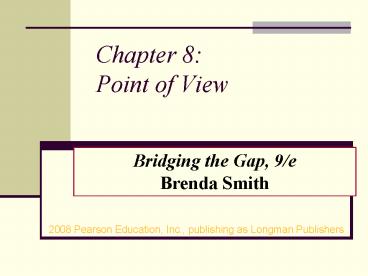Chapter 8: Point of View - PowerPoint PPT Presentation
1 / 19
Title:
Chapter 8: Point of View
Description:
Cynical: expecting the worst from people. Depressed: sad, dejected, or having low spirits. ... remembering the good old days. Serious/Earnest/Sincere: ... – PowerPoint PPT presentation
Number of Views:23
Avg rating:3.0/5.0
Title: Chapter 8: Point of View
1
Chapter 8 Point of View
Bridging the Gap, 9/e Brenda Smith
- 2008 Pearson Education, Inc., publishing as
Longman Publishers
2
In this chapter you will answer the questions
- Is a textbook influenced by the authors point of
view? - What is the authors point of view?
- What is the readers point of view?
- What is the difference between a fact and an
opinion? - What is the authors purpose?
- What is the authors tone?
3
What is the Authors Point of View?
Authors opinions and theories that influence
their presentation of the subject matter
- Point of View
- Suggests thoughtfulness and openness.
- p. 422 426
- Bias
- Facts are slanted toward the authors personal
belief. - An opinion or position on a subject.
4
What is the Readers Point of View
Alternative Arguments
- Open Mind
- Prior knowledge.
- Slightly suspicious nature.
- Closed Mind
- Existing opinions affect how much we accept or
reject. - If beliefs are strong we tune out new material.
5
Readers Tip Questions to Uncover Bias
- What is your opinion on the subject?
- What is the authors opinion on the subject?
- What are the authors credentials for writing on
the subject? - What does the author have to gain?
- Does the author use facts or opinions as support?
- Are the facts selected and slanted to reflect the
authors bias?
6
What is a Fact?
- A Fact
- A fact is a statement based on actual evidence or
personal observation. - It can be checked objectively with empirical
data. - It can be proved to be either true or false.
7
What is an Opinion?
- An Opinion
- An opinion is a statement based upon personal
feelings or judgments. - It reflects a belief or an interpretation rather
than an accumulation of evidence. - It cannot be proved true or false.
8
Fact and Opinion
- Fact Freud believed that the personality is
divided into three parts. - Opinion Freud constructed the most complete
theory of personality development. - Opinion The personality is divided into three
parts the id, the ego, and the superego. - P. 430
9
Authors Purpose
- The reason for writing or reading.
- Persuade
- Inform
- Entertain
10
What is the Authors Purpose?
11
Authors Tone
- The authors attitude or feelings toward the
subject matter.
12
What is the Authors Tone?
- Humorous remarks are designed to be comical
amusing. - Sarcastic remarks are designed to cut or give
pain. - Ironic remarks
- Express something other than the literal meaning.
- Designed to show the incongruity between the
actual and the expected.
13
Recognizing the Authors Tone Part (1)
- Absurd/Ridiculous laughable or a joke.
- Ambivalent having contradictory attitudes or
feelings. - Apathetic not caring.
- Angry feeling bad and upset about the topic.
- Arrogant acting conceited or above others.
- Cheerful feeling good about the topic.
- Complex complicated entangled with confusing
parts.
14
Recognizing the Authors Tone Part (2)
- Congratulatory honoring an achievement
- Cruel mean spirited.
- Cynical expecting the worst from people.
- Depressed sad, dejected, or having low spirits.
- Disapproving judging unfavorably.
- Distressed suffering strain, misery, or agony.
- Disapproving judging unfavorably.
- Evasive, abstruse avoiding or confusing the
issue.
15
Recognizing Authors TonePart (3)
- Formal using an official style
- Frustrated blocked from a goal
- Gentle thoughtful, not pushy, kind
- Hard unfeeling, strict, unrelenting.
- Incredulous unbelieving.
- Intense/Impassioned extremely involved, zealous,
or agitated. - Irreverent lack of respect for authority.
- Objective/Critical using facts without emotions.
16
Recognizing Authors TonePart (4)
- Humorous being funny.
- Incredulous unbelieving.
- Indignant outraged.
- Intense/Impassioned extremely involved, zealous,
or agitated. - Ironic the opposite of what is expected a twist
at the end. - Irreverent lacking respect for authority.
- Mocking/Condemning using facts without emotions.
17
Recognizing Authors TonePart (5)
- Objective factual using facts without emotions.
- Obsequious fawning for attention.
- Optimistic looking on the bright side.
- Outspoken speaking ones mind on issues.
- Pathetic moving one to compassion or pity.
- Pessimistic looking on the negative side.
- Prayerful religiously thankful.
- Reverent showing respect.
- Righteous morally correct.
18
Recognizing Authors TonePart (6)
- Romantic expressing love or affection.
- Sarcastic saying one thing and meaning another.
- Satiric using irony, wit, and sarcasm to
discredit or ridicule. - Sensational over-dramatized or over-hyped.
- Sentimental remembering the good old days.
- Serious/Earnest/Sincere being honest
concerned. - Tragic regrettable or deplorable mistake.
19
Points of View in Editorial Cartoons
- In an editorial cartoon, a point of view is made
without making a direct verbal statement. - This is done through drawings and cartoons.
- See examples in your book or search the net under
editorial cartoons. - p. 444 446
20
To interpret an editorial cartoon, ask
- What is this about? (general topic)
- Who or what is represented by the images shown?
- What is the main point that the cartoonist is
trying to get across? - What is the tone of the cartoon?
- What is the cartoonists purpose?
- What is the cartoonists point of view or
position on the subject? - P. 447
21
Summary Points
- Does a textbook reflect the authors point of
view? - What is the authors point of view?
- What is the readers point of view?
- What is the difference between a fact and an
opinion? - What is the authors purpose?
- What is the authors tone?































